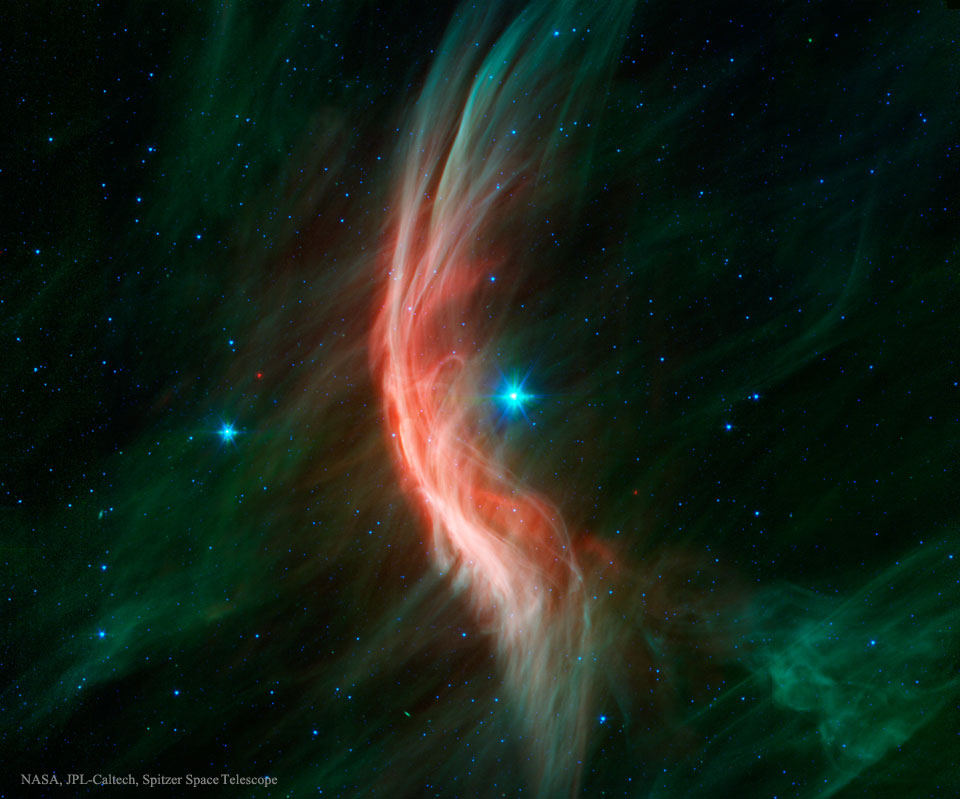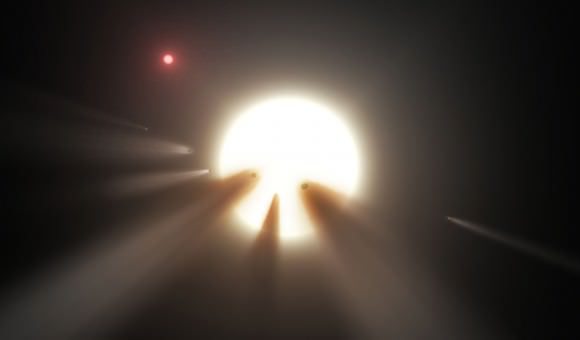Today's APOD is
an old image, from 2012. But it's not as old as the picture of
galaxy NGC 1232, a picture from 1998 that was the APOD for January 1, 2024.
Anyway. Disregarding the infrared bow shock for a moment (or I may not talk about it at all

), Zeta Ophiuchi, the star of the show, has also created a large, if somewhat faint, red hydrogen alpha emission nebula surrounding itself:
The Zeta Ophiuchi nebula is the large red blob at upper left. Below it, you can see the red-yellow-blue nebula surrounding stars Tau Scorpii (red nebula), Antares (yellow nebula) and Rho Ophiuchi (blue nebula). Above blue Rho Ophiuchi you can see another blue nebula, the Blue Horse, and to the right of the Blue Horse is some red nebulosity surrounding stars Delta and Pi Scorpii.
The way I understand it, Zeta Ophiuchi is moving "up and to the left", so it's tempting to think that its birthplace was close to the Antares/Rho Ophiuchi complex.
Let's get back to the concept of runaway stars, shall we? There are some famous and quite blue and massive runaway stars in the sky. The most famous runaways are probably AE Aurigae, 53 Arietis and Mu Columbae, because they are three massive blue stars that were all ejected from the Iota Orionis region just below the Orion Nebula.
Sky & Telescope wrote:
Not only do Mu Col and AE Aur share the same 230,000 mph (100 km/sec) space velocity, they're racing away from one another in almost exactly opposite directions. Just as we trace meteor trails backwards to their radiant, we can trace the paths of Mu Col and AE Aur 2.5 million years back in time. They "meet" in the rich, star-forming regions highlighted by today's Orion Nebula. Today, they're 1,600 light-years apart. Back then, the nebula had only begun to emerge from darkness, awoken by the flickering light of its earliest suns.
...
So what caused the three to abruptly pick up and leave the scene? A supernova explosion might have sent the stars reeling in opposite directions, but recently discovered evidence points to gravitational interactions within a compact star cluster. It's thought that Mu Col and AE Aur once shared company as a binary system that collided or strayed too close to another binary pair. Complicated gravitational interactions ensued, breaking the binary's bond and flinging the stars into space as "runaways" while leaving the other binary intact, still lurking near the scene of the crime.
AE Aurigae has recently blundered into a gas cloud during its headlong flight through space, and, while it is visiting this cloud, it is lighting it up and ionizing it.
AE Aurigae and the Flaming Star Nebula. Credit: Jorge Garcia.
AE Aurigae is moving almost due north, but in the picture above left, north is to the lower right. You can see how the star creates "chaos" in the nebula as it plunges into it, while long streamers of gas seem to fly away from it at left. In the picture at right, north is at left, and the star is moving left.
Ah, but AE Aurigae is making its own bow shock too, as you can see in
this picture from NASA's WISE spacecraft.
And speaking about bow shocks, isn't this a perfectly elegant specimen?
A runaway star has also been discovered apparently kicked out of the humongously large and massive R 136a cluster in the Large Magellanic Cloud:
One of my favorite runaway stars is Zeta Puppis, a rare star because it is so hot:
Wikipedia wrote:
Zeta Puppis has been extensively studied because of the rarity of such hot massive stars and its relative closeness to Earth, but its physical parameters and distance are still poorly known. It would be a valuable step on the cosmic distance ladder, clarifying the distance of other high luminosity stars in the Milky Way galaxy and external galaxies.
The spectral type is O4If(n)p. O4 indicates a hot massive hydrogen-burning star, typically 40,000–44,000K.[6][5][8] The "f" indicates that the spectrum has emission lines of ionised Helium and Nitrogen, not uncommon in somewhat evolved hot O stars and typically identified by the composite emission and absorption profile of the 468.6nm HeII spectral line. The "n" (for nebulous) indicates broadened absorption lines, caused by rapid rotation of the star, in this case over 220 km/s at the equator. The "p" is a general spectral indicator of peculiarity. This combination of spectral characters is unusual because evolved hot stars are expected to rotate relatively slowly after braking by a strong stellar wind, and only 8 stars of this type are known in the Milky Way.
Yeah. Runaway stars are fun! There is a list of some of them
here, although it is not really up to date.
Ann
 Zeta Oph: Runaway Star
Zeta Oph: Runaway Star







